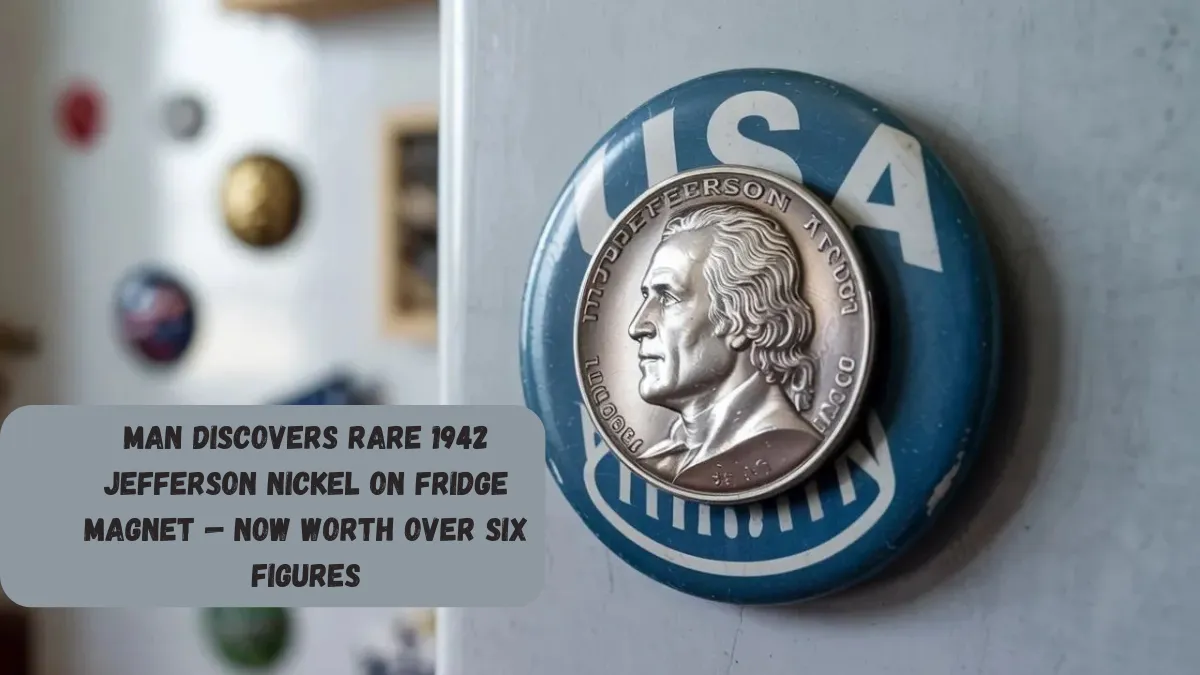Found 1942 Old Jefferson Nickel Stuck: A Hidden Treasure in Plain Sight
What began as a simple kitchen chore turned into an incredible moment of discovery for one homeowner. While tidying up their refrigerator, they noticed that a 1942 Jefferson nickel holding up a grocery list was behaving unusually — it was sticking more firmly to the magnet than it should have.
This odd behavior sparked curiosity. Most people wouldn’t think twice about a common coin, especially one that’s been sitting unnoticed on a fridge for years. But for this sharp-eyed individual, that minor anomaly led to a revelation in the world of numismatics. Little did they know, this seemingly ordinary coin would become the center of a rare and fascinating story.
The Magnetic Mystery Unfolds
The magnetic quality of the 1942 Jefferson nickel raised an immediate red flag for coin experts. Typically, nickels minted in that era — even those produced during the wartime metal changes — are not magnetic. In 1942, the U.S. Mint altered the metal composition of nickels to conserve nickel for the war effort, replacing it with a mix of silver, manganese, and copper. However, these “wartime nickels” still lacked magnetic properties.
When the homeowner took the coin to a local coin shop for evaluation, it was quickly recognized as something extraordinary. A series of tests confirmed the presence of steel in the coin, a material that should not have been used in the production of Jefferson nickels, unveiling an incredibly rare mint error.
A Mint Mistake With Historical Significance
Experts identified the coin as a “transitional error,” a term used when a coin is struck using the wrong type of blank or planchet during a change in metal composition. In this case, a steel planchet, likely intended for another coin denomination or for experimental purposes, had mistakenly been used to mint the 1942 Jefferson nickel.
Such mistakes were more likely during World War II, as the U.S. Mint scrambled to meet production demands amid widespread metal shortages. Transitional errors are incredibly rare, and only a few examples of 1942 nickels struck on steel blanks have ever been verified. The rarity and historical significance of such a piece make it a highly prized item in the world of coin collecting.
From Kitchen Utility to Collector’s Prize
For years, the nickel had unknowingly played the humble role of a refrigerator magnet, quietly holding shopping lists and family photos. Its true identity as a valuable numismatic rarity remained hidden in plain sight. Upon its discovery and proper authentication, experts appraised the coin’s value at potentially $10,000 to $75,000, depending on condition, market demand, and collector interest.
Its unusual origin story — going from a household item to an auction-worthy collectible — adds emotional and historical value. It’s a reminder that incredible stories can emerge from the most mundane circumstances, and that rare historical artifacts are sometimes closer than we think.
Inspiring a New Wave of Treasure Hunters
The story of the 1942 magnetic Jefferson nickel has gone viral across social media and coin-collecting communities. Inspired by this find, many people are now taking a closer look at the coins in their change jars, old drawers, and family keepsakes.
Online forums are buzzing with stories of individuals discovering unusual coins that may have hidden value. This surge in interest isn’t just about the potential for financial gain — it’s also a celebration of history, curiosity, and the joy of discovery. In an era where digital entertainment dominates, the idea that a simple coin could hold such wonder has reignited passion for the tangible relics of the past.
The Enduring Allure of Numismatic Surprises
What makes this story truly captivating is the connection between everyday life and the broader scope of history. The nickel’s accidental journey — from a minting error during wartime America to an overlooked household item, and finally, to a valuable collector’s piece — exemplifies how easily the extraordinary can blend into the ordinary.
Coins like this one are not just worth money; they’re worth stories. They connect us to specific moments in time and the lives of people who lived through them. For collectors, historians, and curious minds alike, the discovery is a beautiful reminder that history doesn’t just live in museums — it often hides in plain sight, waiting to be found.
FAQ
Q1: Why was the 1942 Jefferson nickel magnetic?
A1: The coin was magnetic because it was mistakenly struck on a steel planchet, which is magnetic, instead of the intended wartime alloy containing silver. This type of mint error is extremely rare and occurred during a period of material transitions due to World War II.
Q2: How can I tell if my nickel is valuable?
A2: Look for unusual traits such as magnetic properties, off-center strikes, double dies, or incorrect metal composition. If you suspect an error or rarity, have the coin evaluated by a certified numismatist or grading service.
Q3: What is a transitional error in coin collecting?
A3: A transitional error happens when a coin is struck with the wrong metal planchet during a period when the mint changes the metal composition. These errors are rare and often highly valuable to collectors.
Q4: How much could a rare 1942 nickel like this be worth?
A4: Depending on its condition and rarity, a 1942 transitional error Jefferson nickel struck on a steel planchet could be worth anywhere from $10,000 to $75,000 or more at auction.
